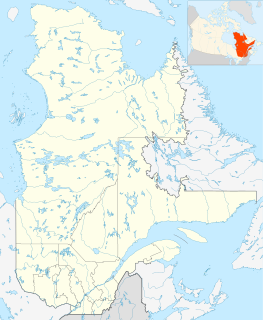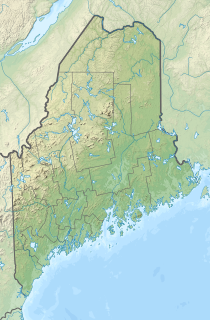See also
- Spikes River, stream
- Chimenticook River, stream
- Saint John River (Bay of Fundy), stream
- Kamouraska Regional County Municipality
- North Maine Woods, a geographical region in northern Maine
East Lake (French: Lac de l'Est) is a lake crossing the Canada-US border located in:
The Northwest shore of the lake has a resort development on the northern part of the lake with the access road.
This waterbody is located on the route 287, at 36 kilometres (22 mi) (including 15 kilometres (9.3 mi) uncoated) to exit 456 of Highway 20. This lake is crossed at its southern limit, by border between the province of Quebec and Maine; this border is located in the Southeast part of the lake. Discharging into the "Little Eastern Lake" through a strait 0.6 kilometres (0.37 mi) long, the Eastern Lake feeds the Chimenticook River, which empties into the Saint John River, which flows into the Maine and New Brunswick.
The mouth of East Lake is located in the township T17 R14 Wels, in North Maine Woods, in the Maine to:
Tapered shape, the lake stretches 9.1 kilometres (5.7 mi) long and a maximum width of 0.8 kilometres (0.50 mi). It is surrounded by mountains whose peaks reach 672 metres (2,205 ft) at northeast and 535 metres (1,755 ft) at southwest side.
The place name has been known for over a century. It refers to its position East of Lake Sainte Anne, an important water body in this border region in the neighboring municipality of Sainte-Perpétue, Chaudière-Appalaches, Quebec. Another name appeared in 1944 on the Township map: Lake Kijemquispam, presumably a Mi'kmaq place name.
The place name "Lac de l’Est " (English: Eastern Lake) was formalized on December 5, 1968, by the Commission de toponymie du Québec (English: Quebec Places Names Board). [1]
This is the logging of the Highlands in Kamouraska that brought people to stand at the head of the lake (northern part). In 1894, the first sawmill is opened by a contractor from New Brunswick, who did the log drive logs toward Saint John River. A winter hamlet quickly developed, serviced by a post office as of 1898. Other mills have succeeded, activity peaking towards 1930 when 300 people permanently living there.
Later, we started to designate this hamlet by the name of Eatonville, but the name of "Lac de l’Est" (English: Eastern Lake) remained. After the 1960, cutting wood decreased and camps of lumberjacks were replaced by cottages, vacationers attracted by a large beach along the lake.

The Big Black River is a river crossing the administrative region of Chaudière-Appalaches in Quebec and in Maine. From its source, in L'Islet RCM, Quebec, the river runs northeast and east across the Canada–United States border in Maine Township 14, Range 16, WELS, to the Saint John River in Northwest Aroostook T 15, R 13.
The Daaquam River is a river primarily flowing in the administrative region of Chaudière-Appalaches, at South of Quebec in Canada and northern Maine, in United States. The river runs from its source, south of Sainte-Justine, northeast across the Canada–United States border to the Northwest Branch of the Saint John River in Maine.

The Northwest Branch Saint John River is a 15.5-mile-long (24.9 km) river primarily in Aroostook County, Maine, USA. Its origin is Frontier Lake (Quebec-Maine) in Quebec, Canada. After crossing the Canada–United States border, the Northwest Branch runs south close to the border until it picks up its tributary, the Daaquam River, which also flows out of Canada. The Northwest Branch then runs generally eastward to its confluence with the Southwest Branch to form the Saint John River.
The Shields Branch is a tributary of the Big Black River), flowing in:
The Southwest Branch Saint John River is a 62.0-mile-long (99.8 km) river in Maine and Quebec. The branch originates in "Little Saint John Lake" on the international boundary between Saint-Zacharie, Quebec and Seboomook Lake Township 5, Range 20, WELS. The branch forms the Canada–United States border as it flows northeasterly to a confluence with the Little Southwest Branch Saint John River in Seboomook Lake Township 9, Range 18, WELS. The Southwest Branch flows briefly into Quebec and then through Maine to its confluence with the Baker Branch Saint John River in Seboomook Lake Township 9, Range 17, WELS. The Southwest Branch finally joins with the Northwest Branch to form the Saint John River.
The West Branch Little Black River is a short river in Quebec and northern Maine.

The ZEC Chapais is a "zone d'exploitation contrôlée" (ZEC) located within the municipality of Mont-Carmel and the unorganized territory of Petit-Lac-Sainte-Anne in the (RCM) Kamouraska Regional County Municipality, in the administrative region of Bas-Saint-Laurent, in Quebec, in Canada.
The river Chimenticook is a tributary of the Saint John River, flowing in the canton T13 R13 Wels, in the Aroostook County, in North of Maine, in United States.
The River Pocwock is a tributary of the Saint John River, flowing in:

The Lake Frontier is a lake located entirely in the municipality of Lac-Frontière, Quebec in regional county municipality (RCM) Montmagny in the administrative region of Chaudière-Appalaches, in Quebec, in Canada.
The Otter River is a tributary of the Northwest Branch Saint John River, flowing in Quebec (Canada) and in Maine. This river crosses the following administrative territories:

The Branche à Jerry is a tributary of the Baker River, flowing in Canada in:
The Brown River is a tributary of the Depot River, flowing in:
The Gobeil River is a tributary of the Big Black River, flowing through:
The West Branch Pocwock Stream is a tributary of the Pocwock River flowing in:
The East Branch Pockwock Stream is a tributary of the Pocwock River, flowing in Townships T17 R13 Wels and T16 R13 Wels, in the Aroostook County, in North Maine Woods, in Maine, the United States.

The Beau Lake is a freshwater lake in the north–south axis through the Saint Francis River. The lake is the center of the boundary between:
The Boucanée River is a tributary of the lake Pohenegamook, flowing in the southern part of the Gaspé Peninsula, in the municipalities of Saint-Athanase, Quebec and Pohenegamook, Quebec, in Témiscouata Regional County Municipality (RCM), in the administrative region of Bas-Saint-Laurent, in Quebec, in Canada.
The Crocs River is a tributary of the Saint John River, in Quebec and New Brunswick, in Canada. The Crocs River flows in the southern part of the Gaspé Peninsula, across the following areas:
The Rivière à l'Île is a tributary of the west bank of the Montmorency River, flowing in the administrative region of Capitale-Nationale, Quebec, Canada. This river successively flows through the regional county municipalities (MRC) of: